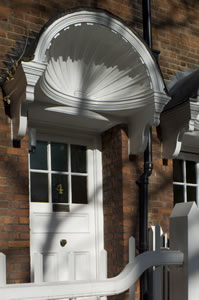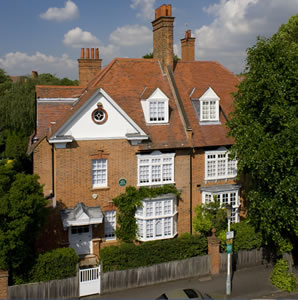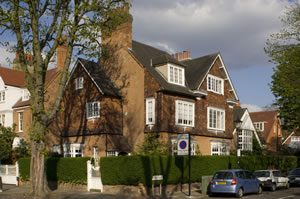Bedford Park and The Aesthetic Movement
Peter Murray discusses their links to tie in with the exhibition at the Victoria & Albert Musem
|
West London was the crucible of the 19th century Aesthetic Movement which sought to escape the ugliness and materialism of the Victorian era by creating a new kind of art and beauty. The Movement, which produced paintings, furniture and interior design, photography and fashion, is the subject of a major exhibition at the Victoria and Albert Museum entitled The Cult of Beauty.
Artists like Whistler and Rosetti and the architect E W Godwin lived in Tite Street in Chelsea, not far from Oscar Wilde, the epitomy of aestheticism; William Morris the senior designer of the movement lived in Hammersmith, while Bedford Park in Chiswick became the place where artists and writers were able to live out the aesthetic lifestyle in the ‘first garden suburb’ in treelined streets and Queen Anne houses with the latest Morris wallpapers and William de Morgan tiles.
Jonathan Carr, the developer of Bedford Park moved in aesthetic circles. His brother was Comyns Carr a director of the Grosvenor Gallery where many of the artists exhibited and was  satirised in Gilbert and Sullivan's Patience, as "greenery-yallery, Grosvenor Gallery". The architect Godwin was key member of the movement with his designs of ebonised Japanese style furniture and buildings that harked back to more rustic times and chimed with the movement’s interest in the pre industrial era, in crafts and medievalism. The architecture was described as the Queen Anne style but had little to do with Queen Anne. It might be better described as ‘old English’ with soft red bricks, tile-hung upper stories, crisply-painted white woodwork, asymmetrical fronts and picturesque massing.
satirised in Gilbert and Sullivan's Patience, as "greenery-yallery, Grosvenor Gallery". The architect Godwin was key member of the movement with his designs of ebonised Japanese style furniture and buildings that harked back to more rustic times and chimed with the movement’s interest in the pre industrial era, in crafts and medievalism. The architecture was described as the Queen Anne style but had little to do with Queen Anne. It might be better described as ‘old English’ with soft red bricks, tile-hung upper stories, crisply-painted white woodwork, asymmetrical fronts and picturesque massing.
In 1875 Carr commissioned Godwin to design the first houses in Bedford Park. These set the style for the suburb, but the architect and developers soon fell out and the role of lead designer for the estate went to R Norman Shaw, the most eminent architect of the time. Shaw designed a series of prototype houses that were then repeated around the development, providing the economy of repetition the developer required but giving the streets a variety and interest that created much of the character of the Bedford Park. As well as the houses, Shaw designed a club for the use of the residents, the Tabard Pub, a cooperative stores and St Michael and All Angels Church. By the early 1980s Bedford Park was the height of fashion. The Club was the heart of the community where fancy dress balls were held in appropriately aesthetic costumes, there were discussions about women’s rights, amateur dramatics, exhibitions, a library as well as billiards and tennis.
 The houses were not expensive and appealed to artists and middle class professionals of modest means. They rented for between £40 and £100 a year. Tenants could choose their interior finishes before moving in and Carr’s workmen would hang the Morris wallpaper and fit the de Morgan tiles around the fireplaces as desired. So popular was Morris’s wallpaper among the residents that it was suggested he should open a branch of his works in Bedford Park. This was despite the fact that Norman Shaw disliked Morris who he thought was full of humbug, overcharging for his products: “being an advanced socialist he cannot do with much less that from 100 per cent to 250 per cent clear profit in his work” Shaw cynically remarked.
The houses were not expensive and appealed to artists and middle class professionals of modest means. They rented for between £40 and £100 a year. Tenants could choose their interior finishes before moving in and Carr’s workmen would hang the Morris wallpaper and fit the de Morgan tiles around the fireplaces as desired. So popular was Morris’s wallpaper among the residents that it was suggested he should open a branch of his works in Bedford Park. This was despite the fact that Norman Shaw disliked Morris who he thought was full of humbug, overcharging for his products: “being an advanced socialist he cannot do with much less that from 100 per cent to 250 per cent clear profit in his work” Shaw cynically remarked.
The people who lived in Bedford Park included W B Yeats – his father and brother, the artists T M Rooke , a pupil of Burne Jones, and the Pre Raphaelite E Blair Leighton; William Terris the actor, Pinero the playwright, Moncure Conway, a fashionable American cleric, and Serge Stepniak a Russian anarchist whose book “Underground Russia” inspired William Morris’s move to a more active socialist agenda.
The Ballad of Bedford Park, published in 1881 in the St James’s Gazette humorously describes the scene:-
With red and blue and sagest green
Were walls and dado dyed
Friezes of Morris there were seen
And oaken wainscot wide
There was a village builded
For all who are aesthete
Whose precious souls it fill did
With utter joy complete
For floors were stained and polished
And every hearth was tiled
And philistines abolished
By Culture’s gracious child
Now he who loves aesthetic cheer
And does not mind the damp
May come and read Rosetti here
By a Japanese-y lamp.
Like the Aesthetic Movement itself, Bedford Park had moved out of the fashionable limelight by the end of the 19th century and for most of the 20th – a period when its innovative designs had a massive influence on suburban developments around the globe – it fell into disrepair. It was rescued in the 1960s by the founding of the Bedford Park Society and the listing of 356 of the houses built by Carr. Since then houses have been restored and extended, house prices have risen dramatically so that while the house are probably in better condition than they have ever been, the number of residents of modest means has fallen. Instead of artists and writers you are more likely to find bankers and lawyers enjoying the benefits of the village where, as the Ballad of Bedford Park described, “men may lead a chaste, correct, aesthetical existence.”
Peter Murray, Deputy Chairman, The Bedford Park Society
The Cult of Beauty: The Aesthetic Movement 1860-1900 takes place at the Victoria and Albert Museum 2 April - 17 July 2011
Bedford Park – the first Garden suburb by T Affleck Greeves is available from Waterstones Chiswick High Road branch or www.bedfordpark.org.uk price £18.95
The Bedford Park Society’s website is at www.bedfordpark.org.uk
March 28, 2011
